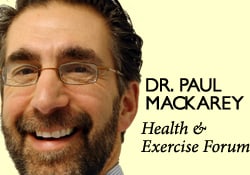 Guest Contributor: Tito Ogunsola, SPT, ATC
Guest Contributor: Tito Ogunsola, SPT, ATC
October is National Physical Therapy Month! Stop by my office at Mackarey & Mackarey PT on Penn Avenue in downtown Scranton for First Friday festivities on Friday October 7 from 5:30 to 8:30 to celebrate PT Month. We will have live music by East Coast Trio and photography by Eileen Barrett Notarianni. Remember to hug your PT today! In honor of PT month, today’s column has been written by a guest contributor from my alma mater, Temple University. Tito Ogunsola, SPT, ATC, Temple University, (Doctor of Physical Therapy 2011), submitted this column as the 2011 recipient of the Dr. Paul Mackarey, Physical Therapy Health Care Journalism Award.
Do long days at work feel like a pain in the neck, literally? Over time, long hours spent in front of the computer or on our feet all day can lead to poor posture and affect the alignment of our bodies. We have all been told to sit up straight more times than we would like to remember, all the while not realizing how severe an impact our posture has on our well being. Poor posture can contribute to neck pain, headaches, low back pain, poor flexibility, jaw pain, shoulder pain, muscular fatigue, as well as declines in overall fitness. Improper body positioning when sitting, standing or when performing daily activities can cause your body to work harder than necessary by over stressing the muscles. The overstressed muscles fatigue and become less efficient, which thereby leads to injury. Fortunately, it is possible to prevent further damage by correcting your everyday bad habits.
The following tips can be implemented in your daily life to help reduce and/or prevent injury:
In conjunction with modifying your posture, it may be necessary to see a medical professional such as your family physician or physical therapist who can further help relieve to your symptoms. This is very important for those with a history of neck or back pain, osteoporosis, scoliosis, or flat feet.
Physical Therapists are experts in conservative management of movement disorders. Physical therapy can teach individuals how to decrease stressful living and working habits. A goal of physical therapy is address patient specific complaints and to correct the existing tissue problems in order to help patient’s function safely when performing life activities. Physical therapy will help patients to avoid further injury by addressing specific impairment such as: decreased range of motion and flexibility, lack of muscular strength, endurance, etc. Physical therapy can also help providing muscle relaxation and pain relieving interventions. On your first visit, you can expect the physical therapist to examine your posture in various positions and conduct a number of examination tests to find where possible muscle imbalances and tissue dysfunctions lie. Moreover, the physical therapist will teach you postural re education techniques that will further help decrease the stressors being placed on your body. To find a licensed physical therapist in your area with orthopedic certification visit: APTA.org or ask your physician for referral.
Visit your doctor regularly and listen to your body.
Guest Contributor: Tito Ogunsola, SPT, ATC, Temple University, Doctor of Physical Therapy 2011, submitted this column as the 2011 recipient of the Dr. Paul Mackarey, Physical Therapy Health Care Journalism Award.
This article is not intended as a substitute for medical treatment. If you have questions related to your medical condition, please contact your family physician. For further inquires related to this topic email: drpmackarey@msn.com
Paul J. Mackarey PT, DHSc, OCS is a Doctor in Health Sciences specializing in orthopaedic and sports physical therapy. Dr. Mackarey is in private practice and is an affiliated faculty member at the University of Scranton, PT Dept.